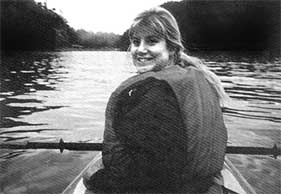 ‘A sense of impending doom was definitely on me. I was starting to think about my funeral. I just didin’t see how we were going to get out of it.’
‘A sense of impending doom was definitely on me. I was starting to think about my funeral. I just didin’t see how we were going to get out of it.’
…….The popularity of both sea kayaking and whale watching has in recent years inspired something of a renaissance in the tiny community of Telegraph Cove on Vancouver Island’s northeast coast. This isolated pocket, once a hub of lumber-related activity, was on the verge of falling silent in 1979 when the Wastell family, for decades the operators of Telegraph Cove Sawmills, closed their antiquated operation. Taking an entrepreneurial leap of faith, employees Bill Mackay and Jim Borrowman teamed up to launch a venture called Stubbs Island Charters. In addition to hauling freight and running dive charters, the pair intended to take the paying public into Johnstone Strait to show them the killer whales that have made the area world famous. Telegraph Cove pioneer Fred Wastell, who had spent much of his life towing logs and hauling lumber in and around Johnstone Strait, told the pair bluntly: “Nobody’s going to pay to look at those darned blackfish.” He did, however, offer to lease them his pride and joy, the sixty-foot Gikumi. From those humble beginnings, Borrowman and Mackay and “those darned blackfish” have made Stubbs Island Charters a major coastal eco-tourism attraction.
……..Kayakers by the thousand make pilgrimages to Johnstone Strait to paddle among killer whales and to explore the adjacent Broughton Archipelago. Many arrive unprepared for the rigorous conditions they’re liable to encounter. As a result, Borrowman and Mackay have over the years delivered many exhausted, wet, humbled kayakers to safety on the Gikumi and its new sister vessel, the Lukwa. For sheer drama, however, none of their rescues match the one they performed on the first day of spring, 1988, with the assistance of fellow Telegraph Cove resident Dan Mooney. In an ironic twist of circumstances, the couple they rescued, Debra Kuykendall (now Debra LeClair), then a student at Oregon State University, and her boyfriend, geologist Kevin Johnson, would almost certainly have died if the high winds which contributed to their misadventure hadn’t forced Mooney to take the day off work. Kevin Johnson:….I’d tried kayaking, not necessarily sea kayaking, but kayaking somewhere, and read something in a magazine about it. I’ve always liked Canada and thought it would be a great opportunity to go out there and give it a try.
……..We drove up to Port Angeles and took the ferry over to Victoria and stopped at a place in Victoria that rented us a sea kayak. They gave us some advice for some nice areas where you could kinda go around a bit—nice protected areas, that kind of stuff. Being totally unfamiliar with the water conditions up there, I thought, “Hell, let’s just drive up the island, look for another spot, maybe we can find a little island to camp out on.” All this kind of thing. That’s pretty much what we did. We drove up the island and ended up in Alert Bay.
…….I was a little more enthusiastic about it than Deb was. I think she was a little more cautious and I was a little more of a risk-taker at the time. We got out there and the weather was a little rainy and a little cool, but nothing unexpected for March. We put in and the water was beautiful, nice and calm, and we went out maybe a mile to an island, got some of our stuff out, set up a camp. There were several little islands there in the area, and there were eagles around and the water was crystal clear.
…….We got up the next day, and the wind had picked up and things were a little more active. Deb was kind of relying on me to be the team leader, and, unfortunately, I was out of my realm. I didn’t have a good grip on what the conditions were out there. I could see the weather was getting a little snotty, but we didn’t have any water there on the island and I was getting a little nervous about staying out there any more than a day. I said, “Let’s go for it, try and make it back to where our car’s parked.” We were both pretty nervous about it.
Deb LeClair:…Things looked pretty choppy. I got that real bad feeling in my gut, looking out and seeing it get progressively worse. Both of our thoughts were, not knowing the weather patterns up there at all, that it could get really bad. We might be stuck here on this island for days. We didn’t have food or water for days.
…….I didn’t feel good about it at all, but he kept reassuring me: “Ah, you know, we grew up on the Oregon coast. This isn’t any worse. It’s no big deal.” Trying to convince me of that. Now when he looks back on it, he knows it was a really wrong choice. I remember at one point almost being in tears about going. Just that feeling of, “No, this isn’t okay,” and, “Wait, I have to go to the bathroom one more time.”
…….By the time we broke down camp, there were definitely whitecaps. That made me real nervous.
…….The other thing was that the chart and the tide book we had didn’t seem to coincide, so we couldn’t even tell the tide for where we were. That was really stupid, because they were against us.
Johnson:..We got through a little bit of rough water and that wasn’t too bad. The tide currents up there are really something, extremely fierce. There was some pretty big water for what the day before had been smooth as glass. Not understanding the tides up there, I didn’t realize that if we’d just held tight for a few hours, it probably would have eased up quite a bit, and we would have had a much easier time of it. We got within probably thirty yards of an island big enough to put in to and get all our stuff up on. It had some trees on it and was somewhat protected. At the time I was aiming at that thing. But we were dealing with something that neither one of us could handle. It was beyond our experience.
LeClair:..The person in the back controls the rudder, and at that point I remember very well asking him why we kept shifting. He kept changing course on me, I thought. We had a plan to head straight for this little island, but out a little bit, then cut in and ride the current into it. And I kept saying, “Why do you keep changing our course?” He didn’t say anything for awhile, and I said, “Why?!” I was getting really tense then. He finally said, “I’m not. I’ve got the rudder all the way the other way.” That’s when I knew that we were in trouble.
……..We were almost to this rocky little island and I remember looking at a log resting on the bank and watching to see if we were making progress. And we were drifting back; the current had taken over. That’s what drew us into this point where apparently the water is coming from one side and the other—there are about three currents pushing together. It was just this great big whitewater mess. That’s where we dumped.
Johnson:… We came up on this standing wave. We got into it crossways and it just rolled us over. Out we went. I told Deb to hang onto the kayak. We gathered up a little bit of our stuff, which took quite a while, ten or fifteen minutes to get up into the kayak. We shot off one flare, probably the best $12.95 I ever spent. The current was picking us up and we went just zooming by the island. She was saying something about trying to swim for it, and I told her, “No way, stick with the boat.”
…….It took us probably twenty minutes to get our act together, and it wasn’t much of an act. Once we did get back in, we were pointed straight into the waves. Every wave went up over me. I had this incredible bruise from the back of the cockpit, from each wave wrenching me back. Some of the time I couldn’t even get my breath.
…….I was able to get my spray skirt on tight, but he couldn’t ever get his on. That was a pretty critical thing. I think we might have been able to recover if he’d have gotten his spray skirt on, because I had a bilge pump and we had an extra paddle—we’d lost both of our other paddles when we went over. But by the time we got into the boat, his hands wouldn’t work. The other thing was that our life jackets kept coming unzipped—both of them. I remember trying to get it zipped up to a certain point, and using my teeth because my hands didn’t work, and every time I looked down, it was just kind of floating around me. Johnson:…We were going farther and farther out into the Johnstone Strait, and there again were hitting these standing waves which are several feet high, and they’re breaking over Deb and coming up on me and going into where I’m sitting. The kayak had bulkheads, but the front one blew out.
…….So we were going along and trying to be encouraging to each other but not doing a very good job of it. We were both real scared. We’d managed to salvage the spare paddle, but in trying to pass the paddle back and forth, she had an end of the blade and was handing it back to me when a gust of wind caught it, and it was ten feet out. It could just as well have been miles.
…….We tried paddling with our hands, but the damn thing was so heavy by now that we weren’t really doing anything except keeping ourselves warm a little bit. We could see a house, and I’m thinking, “I’m going to die out here within sight of a house.” A sense of impending doom was definitely on me. I was starting to think about my funeral. I just didn’t see how we were going to get out of it. I was getting real weak by this time. Deb was in better shape but not able to do anything without me.
LeClair: The wind caught the first flare, and it didn’t really go up into the air. I think it was Kevin’s. I had a flare, and it was like having a candy bar when everyone’s starving, holding onto it and going, ‘I can’t let this go. I have to wait for just the right moment.’ I don’t really know why we didn’t shoot it off sooner. Probably because we were fighting so hard just to keep going. Everything was a struggle. Then, at some point—we were well out into Johnstone Strait by then—we shot off the second one.
Johnson: It seemed like it wasn’t too long after that we saw a boat, which was the Gikumi.
Dan Mooney: I was working as a faller and it was very windy—we’d been blown out for the day. It was around nine or ten in the morning. I was living at Telegraph Cove at the time and had come down from Kokish, which is right up the road. At that time, you could, if you lived there, drive your car right down the boardwalk. I thought I’d just drive down and have a look at the waves—I had nothing else planned for the day. I parked facing the water, got out of my car and was just noticing how big the waves were. It was blowing at a steady forty knots at least. There was pretty big surf out there.
…….I was looking out at the horizon across Johnstone Strait. It would be almost due north as you’re looking out of the cove. About three to five miles out, I saw a big, arcing flare. It was quite brilliant, not that hard to see. You could see it drifting in the wind. It went across the horizon in a fairly wide arc. It stayed visible for somewhere between thirty seconds and a minute. Just the one. When you see a flare under those conditions…I thought, “I wonder if someone’s in trouble out there.”
I turned around and from where I was standing I could see Bill standing in the sitting room on his balcony. I knew he couldn’t hear me, so I mouthed the words, “Did you see that?” He kinda gave me a blank look.Bill Mackay: Dan kind of motioned up to me, and I went, “Yeah, that’s right—it’s coffee time, Dan.” So he comes up—bolting up the stairs—and he says, “Did you see that out there?” And I said, “Yeah, right, Dan, it’s real windy out there. Sit down and have a coffee.” But he said, “No, no, did you see that? I saw a flare, I’m sure I saw a flare.” We said, “Who the heck would be out there? Forget it.” He was insistent. He just couldn’t sit still. And he kept staring—see if he could see it again.
…….He was saying, “Please, do something,” so I phoned the Coast Guard. At the time it was in Alert Bay, and I explained to them that a friend of ours thinks he’s seen a flare out near Cormorant Island. Somewhere in there—the Stubbs Island area.
…….The Coast Guard person immediately said, “Well, did you see it?”
…….”No, I never saw it.”
…….”Did anyone else observe it?”
…….”No, just Dan.”
…….”How reliable is he?”
…….I said, “Well, Dan’s cool. He’s a pretty bright guy.”
…….So they said, “Okay, we’ll phone rescue centre.”
…….They phoned [B.C.’s Rescue Coordination Centre]. Rescue centre phones us back and says, “How reliable is he?” The whole thing, the same thing. And I say, “Well, Dan’s straight, he’s not a wacko.” And they said, “It’s at your discretion, if you want to go, but we’re out of it. Just let us know what you do.”
…….So we sat back down and continued our coffee and Dan just kept hopping. He just kept saying, “We gotta go,” so I phoned rescue centre back and said, “Look this guy’s pretty sure he saw something.” About forty minutes had elapsed by this point.
…….We went down and fired up the Gikumi, and we’ve got a thirty-foot skiff as well. We towed the skiff. What we normally do when we set something like this up is, the bigger boat will go and handle the rougher water, and the smaller vessel will do in amongst the islands, going in and checking with people, see if they’ve seen anything—just generally doing the shore search stuff.
…….So away we went. And boy, it was rough. We were taking a beating. The wind’s picking up and we’re up to about 60, 65 knots when you get out there—really blowing—and a big ebb tide: the ocean’s flying out of here heading for Japan, about 7 knots. Dan’s really on point; we’re all on point, but sort of yawning at the same time, like, “Why are we here? This is really absurd.”
…….As we’re cruising down the backside of Pearse Island, I see what appears to be a flour bag, a yellow flour bag. And I think, “That’s pretty dumb, people throwing their garbage out.” So I jumped in the skiff to check that out. I recognized that it was kayak stuff. I undid the Velcro and it’s got women’s stuff in it and a little camera. And it’s all dry as a bone. Well, my heart stopped. I just knew there was something serious going on. And we weren’t that far off the mark.
…….I went back to the Gikumi right away to tell Jim. I threw the bag at them, and Dan just started rejoicing. He couldn’t believe it: there was really something going on. They went through the rest of the bag to see if there was any name or anything on it—anything identifiable. And there was nothing.
Mooney: When we found that, it really confirmed that someone was in trouble out there. That was when we really started to peel our eyes. Up until that point, we were thinking maybe it was a false alarm. We didn’t have anything concrete to prove that there was anybody in trouble.
…….Then, when Jim radioed Coast Guard that we’d found the bag, the skipper on the Alert Bay ferry run interjected in the transmission and said something to the effect that, “Yah, I saw a couple of kayakers going over about two days ago, and they haven’t come back on the ferry yet.”
Jim Borrowman: Bill went off to the southeast corner of the Pearse Islands and started searching in that area. The reason he went in the skiff up there is that there are small, tight little channels, and it’s really difficult to get a big boat in there. And that’s where the fifty-knot winds were smashing against; it was quite a rough area right in there. I just couldn’t get in very close because of the reefs.
…….So we carried on west down the side of the Pearse Islands. We went right down the full length of them. We went into a channel inside the Pearse Islands and did a circuit in there, but there was nothing, so we came back out and were going to go a parallel route east back up Cormorant Channel. We got up not very far and Dan says, “I think I saw something.”
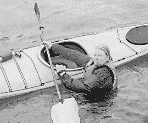
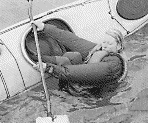
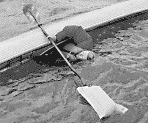
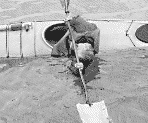
While the paddle float was devised as a way to improvise an outrigger for self-rescue, its best use, in my opinion, is as an aid to a reentry and roll. Once the rudimentary principles of a roll are mastered, a reentry and roll with a paddle float can offer a reliable self-rescue, even though rolling without the float might still be elusive.
For a reentry, flip the kayak upright, float yourself alongside the kayak facing the bow, and grasp the paddle against the far side of your cockpit so that it extends out at right angles past you with the float as far from the side as possible. Grip the near side of your cockpit with your other hand. Lie back in the water. Hold your breath and swing your feet into the cockpit between your hands. Still gripping both sides of the cockpit, wriggle yourself into your seat, and with your feet on the foot braces, grip firmly with your knees. Now grasp the paddle shaft with both hands and gently pull down against the buoyancy of the paddle float until your head reaches the surface and you can breathe and see what you are doing. Relax now in this position. Finish your roll by pulling down on the paddle with the hand closest to the paddle float, pushing your head down toward the water and flicking with your hips to right the kayak. When the kayak is upright, bring your head inboard close over the deck. Maintain your balance with the aid of the paddle float by gripping it tightly across the cockpit coaming. As with the previous paddle float self-rescue, in windy conditions or in waves or surf, enter from the side the waves are approaching from so that you are bracing on the correct side once you are upright.
If you practice the reentry and roll with a paddle float and find it straightforward, try deflating the float a little. The less buoyancy you need in the float, the more efficient your hip flick is becoming. Ultimately you might aim to be able to self-rescue without a float, but then you can still carry the float as a back-up in case you need it sometime.
Of course practicing a roll with a paddle float is a good way of gaining confidence for rolling without a float. It is also an excellent way to improve your hip flick until it is almost effortless. Use the float for practicing paddle braces until you can brace with confidence and can progress to bracing without a float with no fear of failure. Regularly using a paddle float increases your familiarity with it and helps you gauge its advantages and limitations for yourself. To improve your sense of balance, try reentering without the paddle float, going through all the moves on calm water. Then rehearse with your float in varying conditions until you know what you are capable of with a float rescue.

